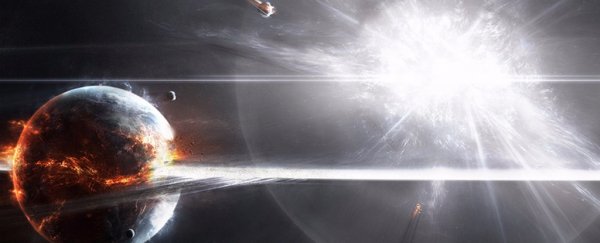Sometimes, when a massive star reaches the end of its life, its core collapses in on itself, causing an epic explosion that can light up the entire sky.
If this explosion happens close enough to our planet, it can bombard us with high-energy radiation.
A new paper published in The Astrophysical Journal Letters explores the effects of two exploding stars, or supernovae, that occurred somewhere between 1.7 to 3.2 million and 6.5 to 8.7 million years ago.
The scientists used computer models to follow the radiation down through Earth's atmosphere to find out its effects, as well as how much of it actually reached the ground.
What they found was surprising.
Bathing in cosmic radiation
According to their models, at first, the explosions would have caused blue light in the night sky "brilliant enough to disrupt animals' sleep patterns for a few weeks," said a University of Kansas press release.
Then, the explosion would have exposed our atmosphere and biology to a "long-lasting gush of cosmic radiation". For hundreds to thousands of years, this radiation would have increased by a factor of a few hundred.
This boost in radiation would have had "substantial effects on the terrestrial atmosphere and biota", the authors wrote in the study, causing as much as a 20-fold increase in irradiation by cosmic particles at Earth's surface. This would just about triple the radiation dose that creatures at ground level would be exposed to.
Melott said this radiation would have packed doses equivalent to one CT scan per year for every creature living on land and in shallow parts of the ocean. This increase in radiation would have been high enough to boost the mutation rate and frequency of cancer, as well as possibly speed up evolution.
An era of lightning
As the radiation poured down on Earth, it would have ionized the atmosphere, tearing apart atoms and molecules, so that electrons were running around by themselves, kind of like gas inside fluorescent tube.
This would conduct electricity easier, so scientists think that there's a good chance that the rate of lightning may have increased a lot during the hundreds to thousands of years that cosmic radiation was hitting Earth.
This could have caused more wildfires and could have potentially changed the climate of the planet. In fact, the more recent explosion coincides with a minor mass extinction around 2.59 million years ago.
"There was climate change around this time," Adrian Melott, professor of physics at the University of Kansas and co-author the new paper, said in a press release.
"Africa dried out, and a lot of the forest turned into savanna. Around this time and afterwards, we started having glaciations - ice ages - over and over again, and it's not clear why that started to happen. It's controversial, but maybe cosmic rays had something to do with it."
What comes next
The next step is for scientists to look at the geological record around the time of the more recent explosion, and see if there were more things like wildfires and mutations.
At the time of the study, the scientists believed the explosions both happened about 300 light-years away, but new results that have come out since the paper was published that suggest that one of the explosions might have happened at about half that distance. So, the scientists also plan to redo their models with that shorter distance. They expect that the effects will be even bigger.
Even though these explosions might have transformed life on Earth at that time, you shouldn't be too worried about their effects on us.
"This is not something for people to worry about for the immediate future," Melott said. "Events like this only come along over long time periods of millions and millions of years."
This article was originally published by Business Insider.
More from Business Insider:
